Study on Bidirectional Blasting Technology for Composite Sandstone Roof in Gob-Side Entry-Retaining Mining Method
Abstract
:1. Introduction
2. Theoretical Analysis of BBT
2.1. Mechanical Model of BBT
2.2. Crack Propagation of BBT
3. Simulation of BBT
3.1. Numerical Model
3.2. Algorithm and Material Parameters
| Parameter | RO/(g·cm−3) | A | B | N | C |
|---|---|---|---|---|---|
| Value | 2.7 | 0.79 | 1.6 | 0.61 | 0.007 |
3.3. Numerical Simulation Results
4. BBT In Situ Blasting Test
4.1. Engineering Geological Conditions
4.1.1. Test Working Face Conditions
4.1.2. Coal Seam and Strata
4.2. Design of BBT
4.2.1. The Angle of BBT
4.2.2. Blasthole Depth of BBT
4.2.3. Blasthole Distance of BBT
4.3. Explosive Charge Structure Test
4.3.1. Plan of BBT
4.3.2. Test Construction Process of BBT
5. Results and Discussion
5.1. Blasthole Crack Propagation
5.2. Crack Growth Effectiveness
5.3. Entry-Retaining Results
6. Conclusions
Author Contributions
Funding
Institutional Review Board Statement
Informed Consent Statement
Data Availability Statement
Conflicts of Interest
References
- He, M.C.; Wang, Q.; Wu, Q.Y. Innovation and future of mining rock mechanics. J. Rock Mech. Geotech. Eng. 2021, 13, 1–21. [Google Scholar] [CrossRef]
- Zhu, Z.; Zhang, K.X.; He, M.C.; Yang, J.; Gao, Q.; Wei, Q.L. Surrounding rocks control technology and application of automatically formed roadway in mining without coal pillar and gateroad excavation. J. China Coal Soc. 2018, 43, 52–60. [Google Scholar]
- Peng, L.J.; Zhang, D.F.; Guo, Z.B.; Duan, Q.W. Numerical analysis of thick coal seam small pillar along gob roadway and its application. Rock Soil Mech. 2013, 34, 3619–3632. [Google Scholar]
- Zhang, G.C.; He, F.L.; Lai, Y.H.; Song, J.W.; Xiao, P. Reasonable width and control technique of segment coal pillar with high-intensity fully-mechanized caving mining. J. China Coal Soc. 2016, 41, 2188–2194. [Google Scholar]
- Lu, Y.Z.; Akhtar, S.; Sasmito, A.P.; Kurnia, J.C. Prediction of air flow, methane, and coal dust dispersion in a room and pillar mining face. Int. J. Min. Sci. Technol. 2017, 27, 657–662. [Google Scholar]
- Yang, K.; Gou, P.F. Research on Reasonable width of coal pillars in high strength mining roadway in Wantugou mine. Geotech. Geol. Eng. 2021, 39, 2065–2073. [Google Scholar] [CrossRef]
- Li, Y.F.; Hua, X.Z. Mechanical analysis of stability of key blocks of overlying strata for gob-side entry retaining and calculating width of roadside backfill. Rock Soil Mech. 2012, 33, 1134–1140. [Google Scholar]
- Bai, J.B.; Zhou, H.Q.; Hou, C.J. Development of support technology beside roadway in goaf-side entry retaining for new sublevel. J. China Univ. Min. Technol. 2004, 33, 183–186. [Google Scholar]
- Gao, Y.B.; Yang, J.; Zhang, X.Y.; Xue, H.J.; He, M.C. Study on surrounding rock control of roadways in deep coal mines based on roof cutting and pressure release technology by directional tensile blasting. Chin. J. Rock Mech. Eng. 2019, 38, 2045–2056. [Google Scholar]
- Gao, Y.B.; He, M.C.; Yang, J.; Ma, X.G. Experimental study of caving and distribution of gangues influenced by roof fracturing in pillarless mining with gob-side entry retaining. J. China Univ. Min. Technol. 2018, 47, 21–31. [Google Scholar]
- Wang, Q.; He, M.C.; Yang, J.; Gao, H.K.; Jiang, B.; Yu, H.C. Study of a no-pillar mining technique with automatically formed gob-side entry retaining for longwall mining in coal mines. Int. J. Rock Mech. Min. Sci. 2018, 110, 1–8. [Google Scholar] [CrossRef]
- Zhang, Z.Z.; Wang, W.J.; Li, S.Q.; Bai, J.B.; Hao, S.P.; Wu, H.; Yu, X.Y. An Innovative Approach for Gob-Side Entry Retaining With Thick and Hard Roof: A Case Study. Teh. Vjesn. Tech. Gaz. 2018, 25, 1028–1036. [Google Scholar]
- Meng, N.; Bai, J.B.; Chen, Y.; Wang, X.; Wu, W.; Wu, B. Stability analysis of roadside backfill body at gob-side entry retaining under combined static and dynamic loading. Eng. Fail. Anal. 2021, 127, 105531. [Google Scholar] [CrossRef]
- Chen, J.Y. Research on collaborative control technology for surrounding rock pressure relief and support of gob-side entry. Coal Sci. Technol. 2020, 48, 44–49. [Google Scholar]
- Su, B. Application of directional hydraulic fracturing and pressure relief technology for roof suspending at the working face end. Coal Eng. 2021, 53, 80–84. [Google Scholar]
- Zhang, R.; Cai, Q.W.; Huang, B.X. Deformation control of main roadway using roof hydraulic fracturing in Guqiao Coal Mine. Coal Eng. 2021, 53, 45–50. [Google Scholar]
- Pang, G.G. Hard roof hydraulic fracturing and the effect inspection. Coal Eng. 2021, 53, 27–30. [Google Scholar]
- Sun, Y.X.; Fu, Y.K.; Wang, T. Field application of directional hydraulic fracturing technology for controlling thick hard roof: A case study. Arab. J. Geosci. 2021, 14, 1–15. [Google Scholar] [CrossRef]
- Chen, Y.; Ma, S.; Yang, Y.; Meng, N.; Bai, J. Application of Shallow-Hole Blasting in Improving the Stability of Gob-Side Retaining Entry in Deep Mines: A Case Study. Energies 2019, 12, 3623. [Google Scholar] [CrossRef] [Green Version]
- Krol, R.; Kawalec, W.; Gladysiewicz, L. An Effective Belt Conveyor for Underground Ore Transportation Systems. IOP Conf. Ser. Earth Environ. Sci. 2017, 95, 042047. [Google Scholar] [CrossRef]
- Król, R. Studies of The Durability of Belt Conveyor Idlers with Working Loads Taken into Account. IOP Conf. Ser. Earth Environ. Sci. 2017, 95, 042054. [Google Scholar] [CrossRef] [Green Version]
- Król, R.; Kisielewski, W. Research of loading carrying idlers used in belt conveyor–practical applications. Diagnostyka 2014, 15, 67–73. [Google Scholar]
- He, M.C.; Cao, W.F.; Shan, R.L.; Wang, S.L. New blasting technology bilateral cumulative tensile explosion. Chin. J. Rock Mech. Eng. 2003, 22, 2047–2051. [Google Scholar]
- Gao, Y.B.; Wang, Y.J.; Yang, J.; Zhang, X.Y.; He, M.C. Meso- and macroeffects of roof split blasting on the stability of gateroad surroundings in an innovative nonpillar mining method. Tunn. Undergr. Space Technol. 2019, 90, 99–118. [Google Scholar] [CrossRef]
- Zhang, X.Y.; Hu, J.Z.; Xue, H.J.; Mao, W.B.; Gao, Y.B.; Yang, J.; He, M.C. Innovative approach based on roof cutting by energy-gathering blasting for protecting roadways in coal mines. Tunn. Undergr. Space Technol. 2020, 99, 103387. [Google Scholar] [CrossRef]
- Hu, J.; Zhang, X.; Gao, Y.; Ma, Z.; Xu, X.; Zhang, X. Directional presplit blasting in an innovative no-pillar mining approach. J. Geophys. Eng. 2019, 16, 875–893. [Google Scholar] [CrossRef]
- Zhang, X.Y.; Pak, R.Y.; Gao, Y.; Liu, C.; Zhang, C.; Yang, J.; He, M. Field experiment on directional roof presplitting for pressure relief of retained roadways. Int. J. Rock Mech. Min. Sci. 2020, 134, 104436. [Google Scholar] [CrossRef]
- Zhang, X.Y.; He, M.C.; Yang, J.; Wang, E.Y.; Zhang, J.B.; Sun, Y. An Innovative Non-Pillar Coal-Mining Technology with Automatically Formed Entry: A Case Study. Engineering 2020, 6, 1315–1329. [Google Scholar] [CrossRef]
- Guo, D.Y.; Shang, D.Y.; Lv, P.F.; Wang, S.Y.; Wang, J.M. Experimental research of deep-hole cumulative blasting in hard roof weakening. J. China Coal Soc. 2013, 7, 1149–1153. [Google Scholar]
- Zhang, Z.C. On the initiating, glowing branching and sloping of crack in rock blasting. Blasting 1999, 16, 21–24. [Google Scholar]
- Gao, Y.B.; Yang, J.; Wang, Q.; Wang, Y.J.; He, M.C. Mechanism of roof presplitting in a nonpillar mining method with entry auomatically retained and its influence on the strata behaviors. J. China Coal Soc. 2019, 44, 3349–3359. [Google Scholar]
- Yang, X.; Hou, L.; Xue, H.; Yuan, D.; Cao, J.; Han, Z.; Gao, Y. Pressure distribution and deformation control of gob-side entry retaining formed by roof cutting influenced by abandoned roadways. Geotech. Geol. Eng. 2021, 39, 2533–2545. [Google Scholar] [CrossRef]
- Sun, X.M.; Ye, C.L.; Hu, Y.C.; Zhang, K.; Liu, B.L.; Xue, Q.L. Numerical simulation analysis of rock blasting structure based on ANSYS/LSDYNA. Explor. Eng. Rock Soil Drill. Tunn. 2019, 46, 87–93. [Google Scholar]
- Hao, S.Y.; Bi, C.C.; Wang, Z.L. Study on Influence of Time Step on Calculation Result in Blasting Simulation with LS-DYNA. Blasting 2016, 33, 39–45. [Google Scholar]
- Ma, G.W.; An, X.M. Numerical simulation of blasting-induced rock fractures. Int. J. Rock Mech. Min. Sci. 2008, 45, 966–975. [Google Scholar] [CrossRef]
- He, M.C.; Guo, P.F.; Zhang, X.H.; Wang, J. Directional pre-cracking of roadway roof based on two-way energy-accumulating tension blasting theory. Explos. Shock Waves 2018, 38, 795–803. [Google Scholar]
- Yang, X.; Liu, C.; Ji, Y.; Zhang, X.; Wang, S. Research on roof cutting and pressure releasing technology of directional fracture blasting in dynamic pressure roadway. Geotech. Geol. Eng. 2019, 37, 1555–1567. [Google Scholar] [CrossRef]
- Steinberg, D.J.; Cochran, S.G.; Guinan, M.W. A constitutive model for metals applicable at high-strain rate. J. Appl. Phys. 1980, 51, 1498–1504. [Google Scholar] [CrossRef] [Green Version]
- Chen, W.S.; Hao, H.; Chen, S.Y. Numerical analysis of prestressed reinforced concrete beam subjected to blast loading. Mater. Des. 2015, 65, 662–674. [Google Scholar] [CrossRef]
- Li, N.; Zhao, J.H.; Wu, S.; Wang, J.; Shi, M.J. Blast response of steel fiber reinforced high strength concrete walls based on CONWEP. Eng. Blasting 2008, 12, 8–11. [Google Scholar]
- Li, H.C.; Chen, Y.; Liu, D.S.; Huang, Y.H.; Zhao, L. Sensitivity Analysis Determination and Optimization of Rock RHT Parameters. Trans. Beijing Inst. Technol. 2018, 38, 779–785. [Google Scholar]
- Guo, Z.B.; Wang, J.; Cao, T.P.; Chen, L.; Wang, J. Research on key parameters of gob-side entry retaining automatically formed by roof cutting and pressure release in thin coal seam mining. J. China Univ. Min. Technol. 2016, 05, 879–885. [Google Scholar]
- Xue, H.; Gao, Y.; Zhang, X.; Tian, X.; Wang, H.; Yuan, D. Directional Blasting Fracturing Technology for the Stability Control of Key Strata in Deep Thick Coal Mining. Energies 2019, 12, 4665. [Google Scholar] [CrossRef] [Green Version]
- Ma, X.G.; He, M.C.; LI, Z.; Liu, X.Y.; Yu, G.Y.; DU, H.R. Key parameters of gob-side entry retaining automatically formed by roof cutting and blasting in compound roof condition. J. China Univ. Min. Technol. 2019, 48, 236–246. [Google Scholar]
- Wang, Q.; Qin, Q.; Jiang, B.; Xu, S.; Zeng, Z.N.; Luan, Y.C.; Liu, B.H.; Zhang, H.J. Mechanized construction of fabricated arches for large-diameter tunnels. Autom. Constr. 2021, 124, 103583. [Google Scholar] [CrossRef]
- Wang, Q.; He, M.C.; Li, S.; Jiang, Z.H.; Wang, Y.; Qin, Q.; Jiang, B. Comparative study of model tests on automatically formed roadway and gob-side entry driving in deep coal mines. Int. J. Min. Sci. Technol. 2021, 31, 591–601. [Google Scholar] [CrossRef]

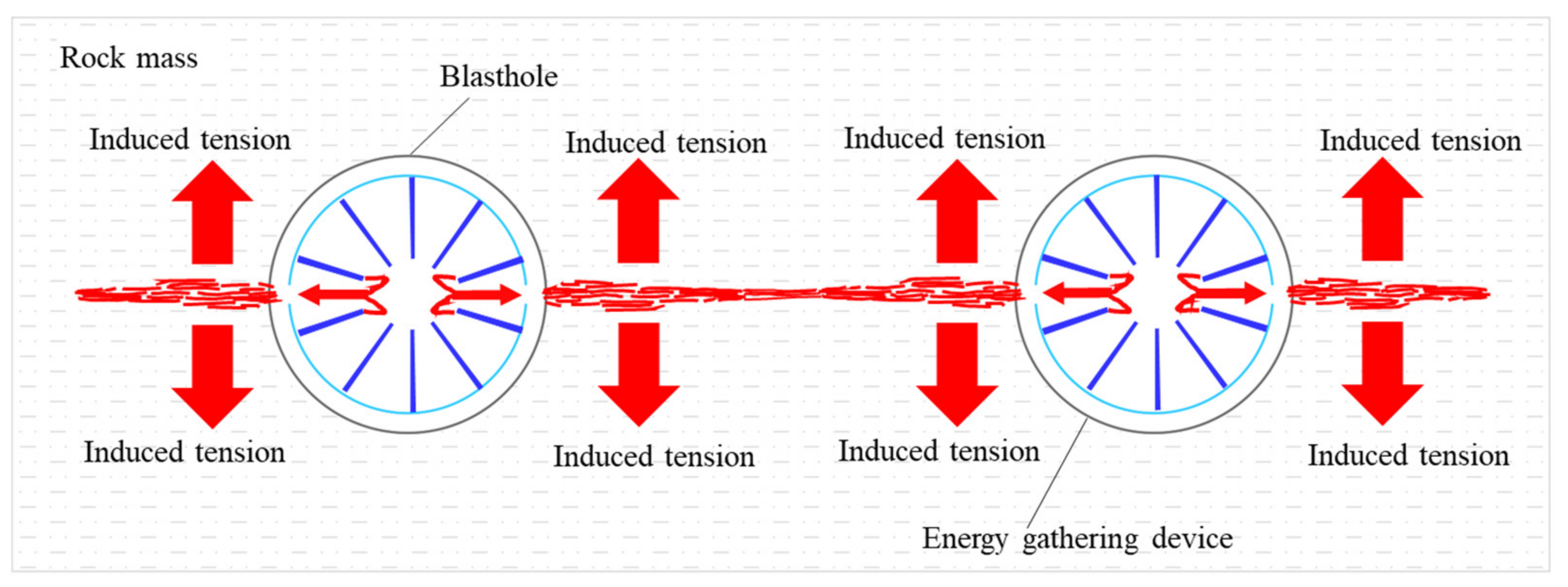
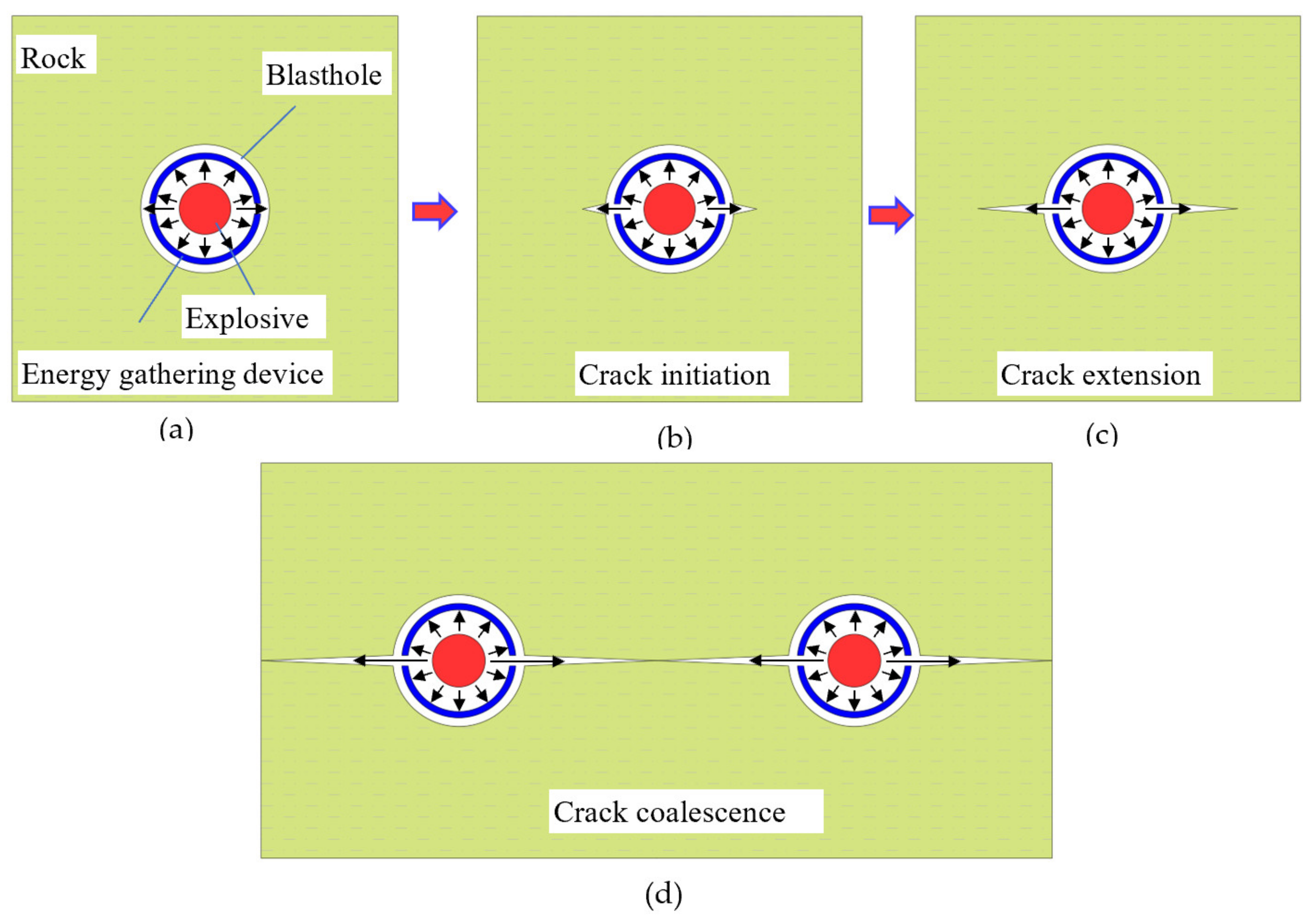
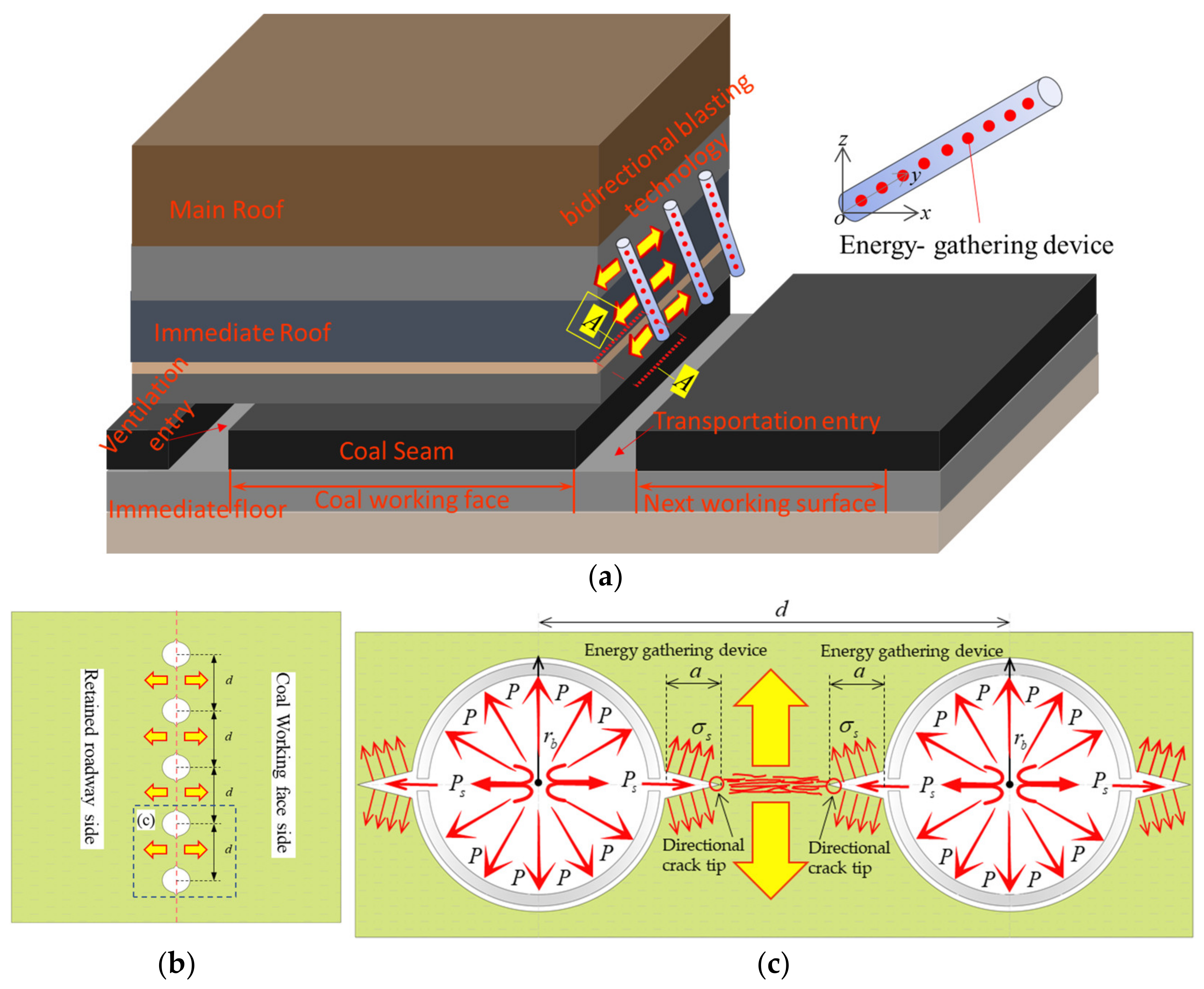
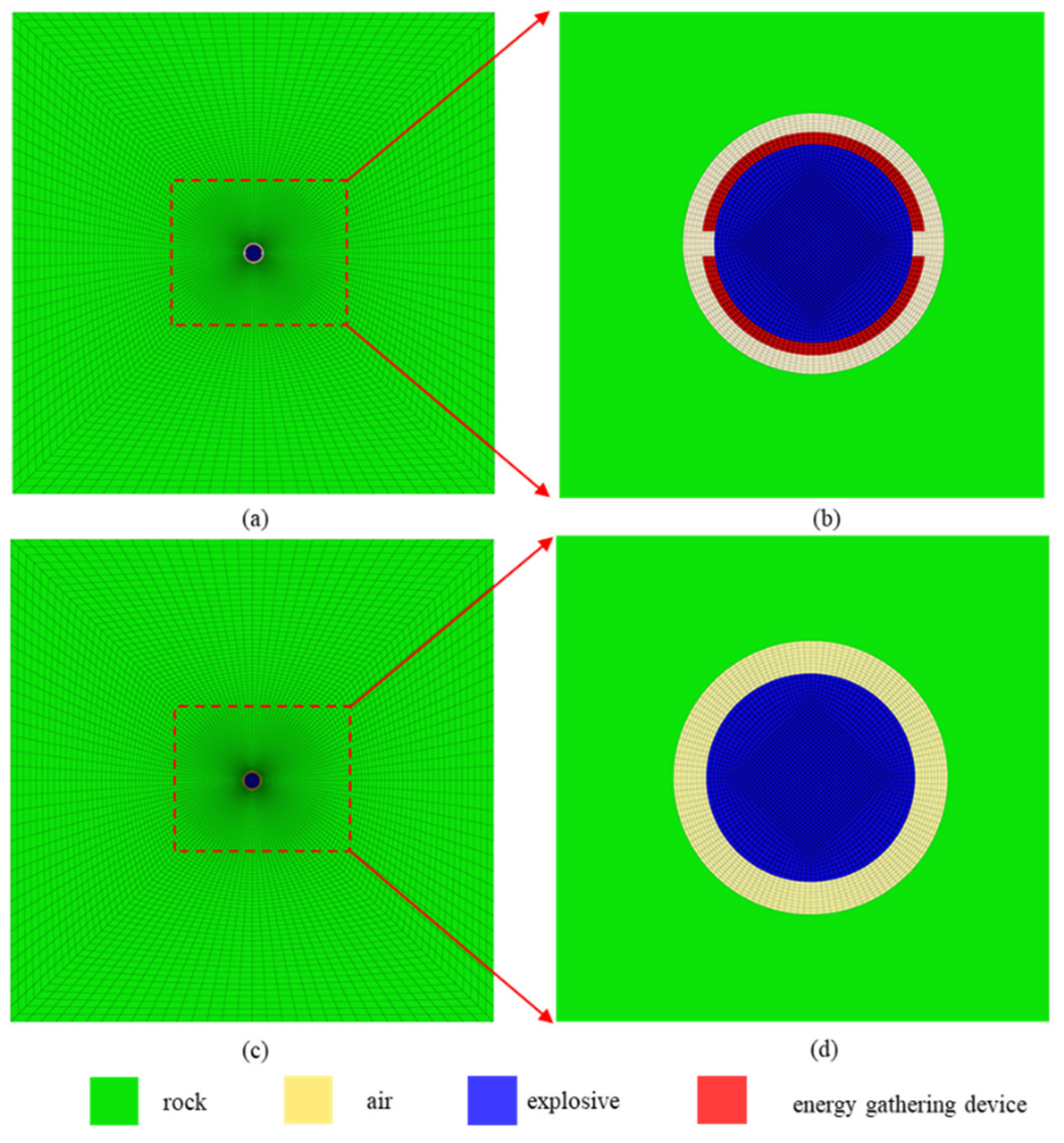
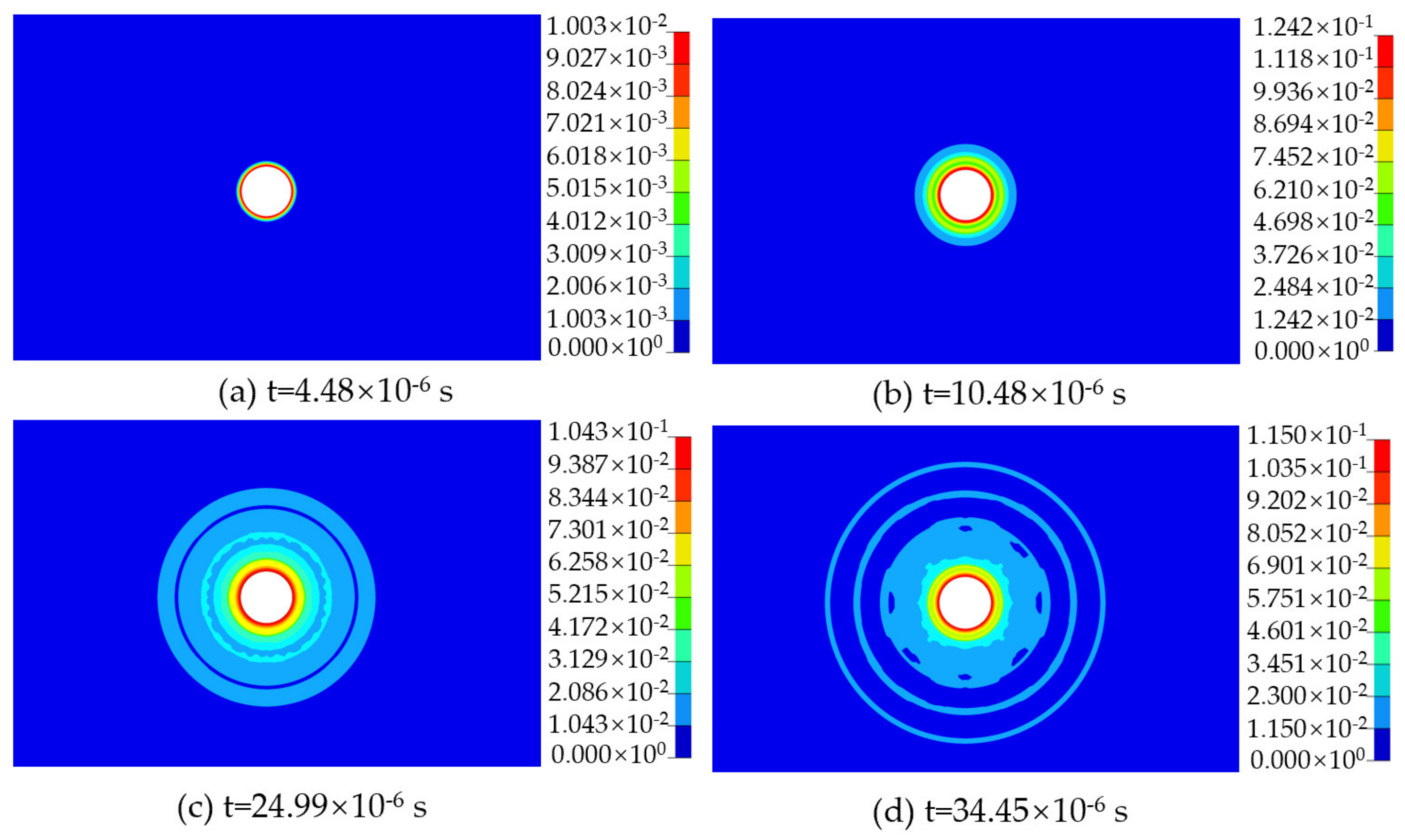
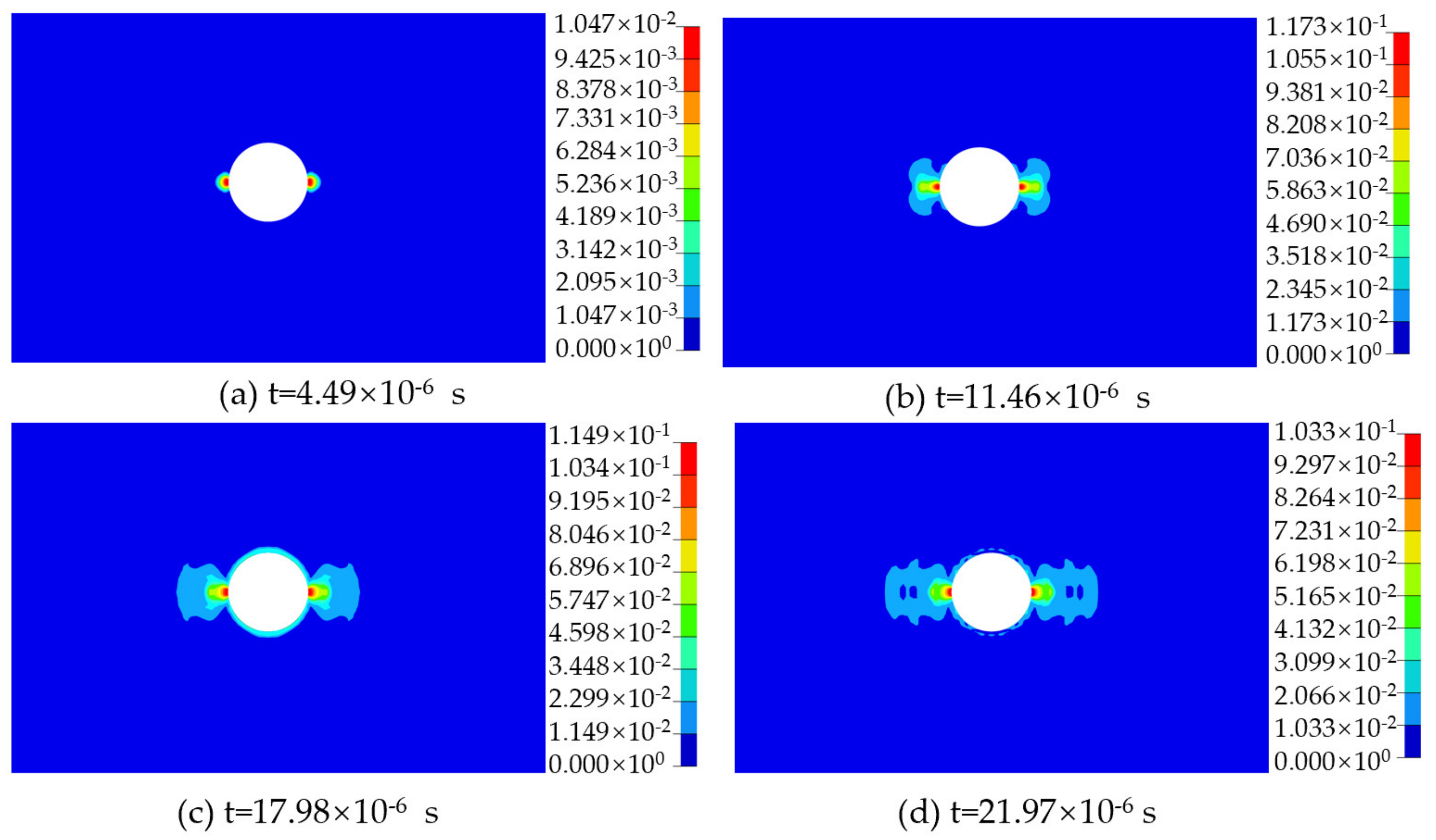
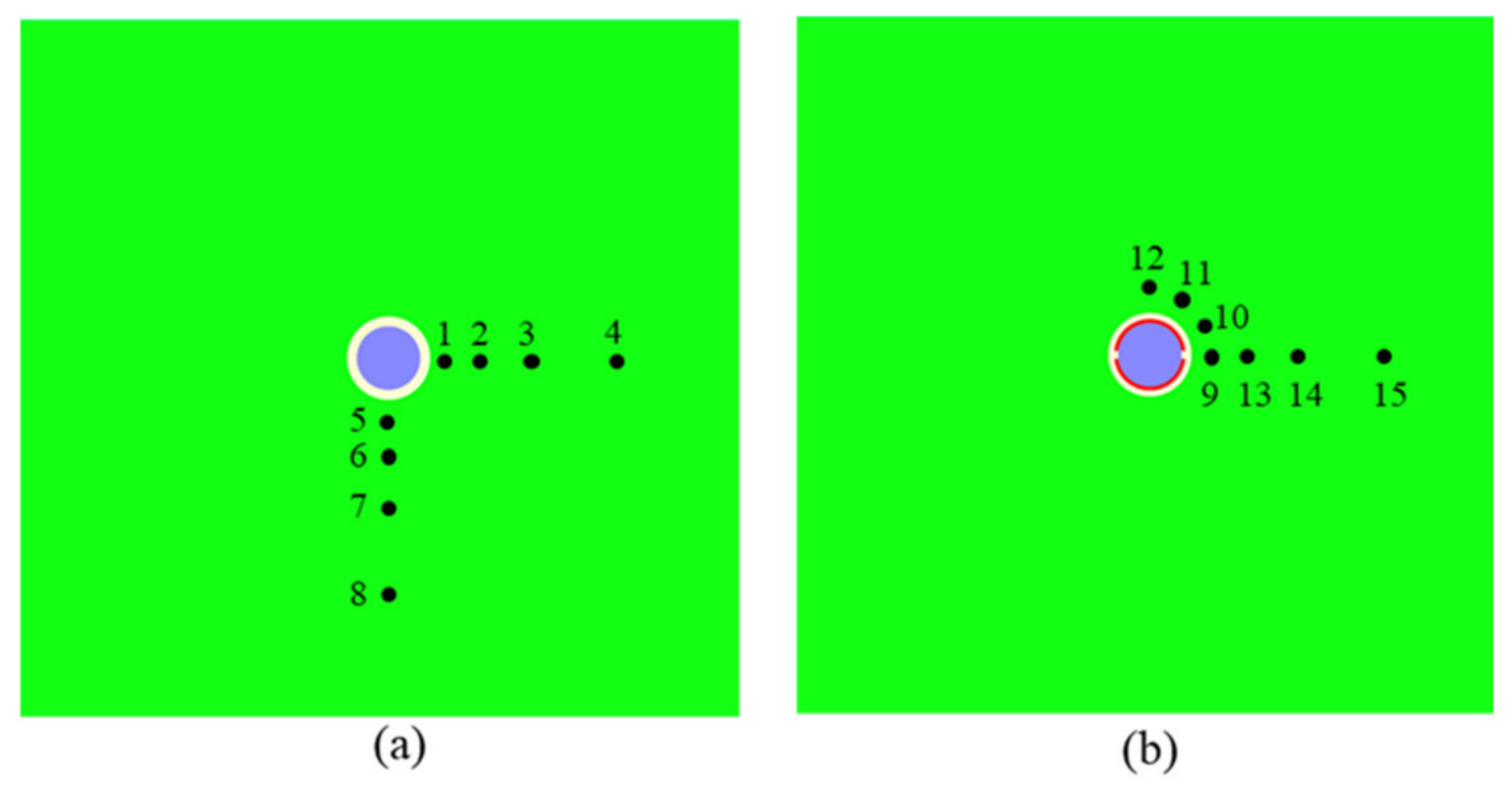

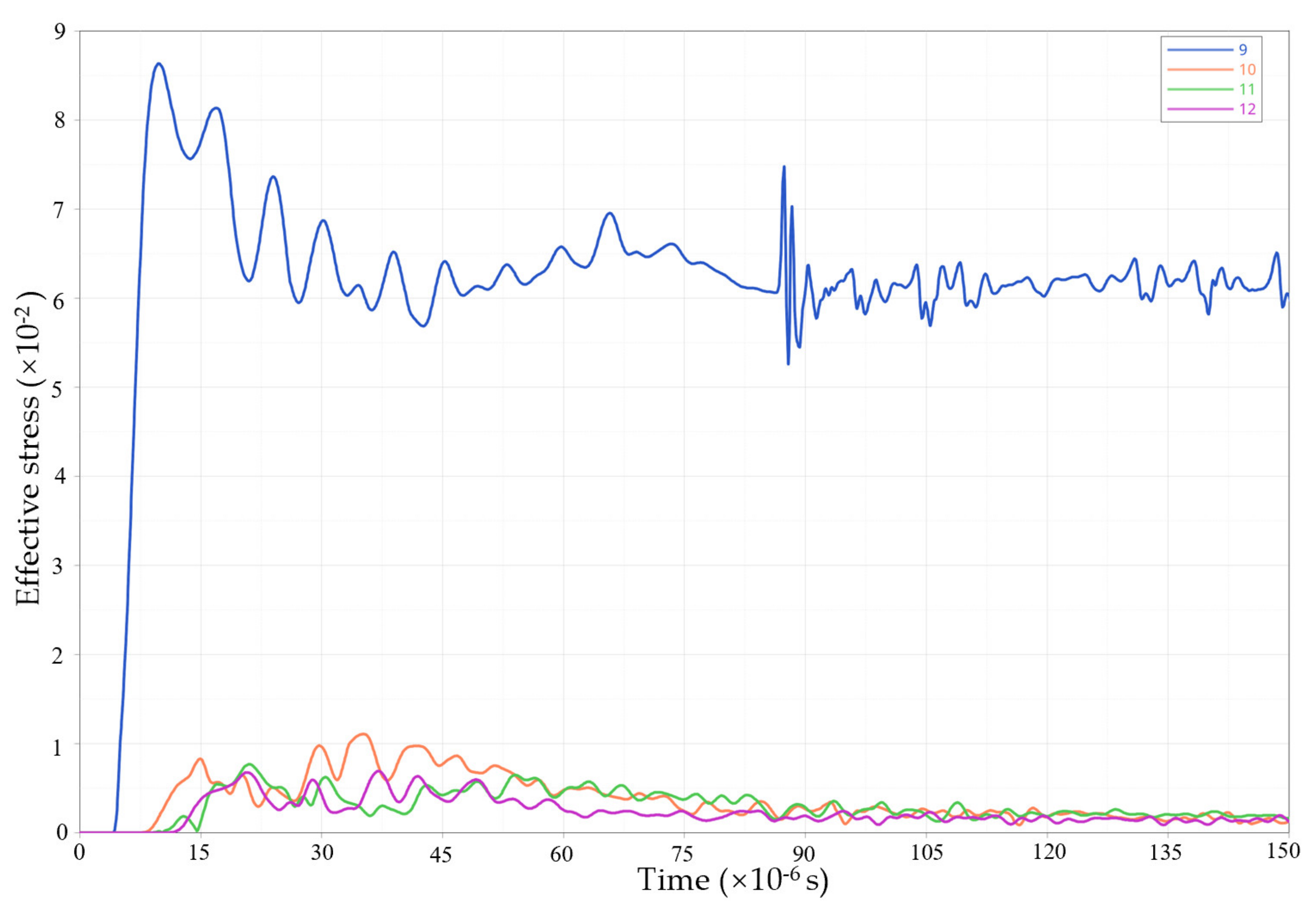
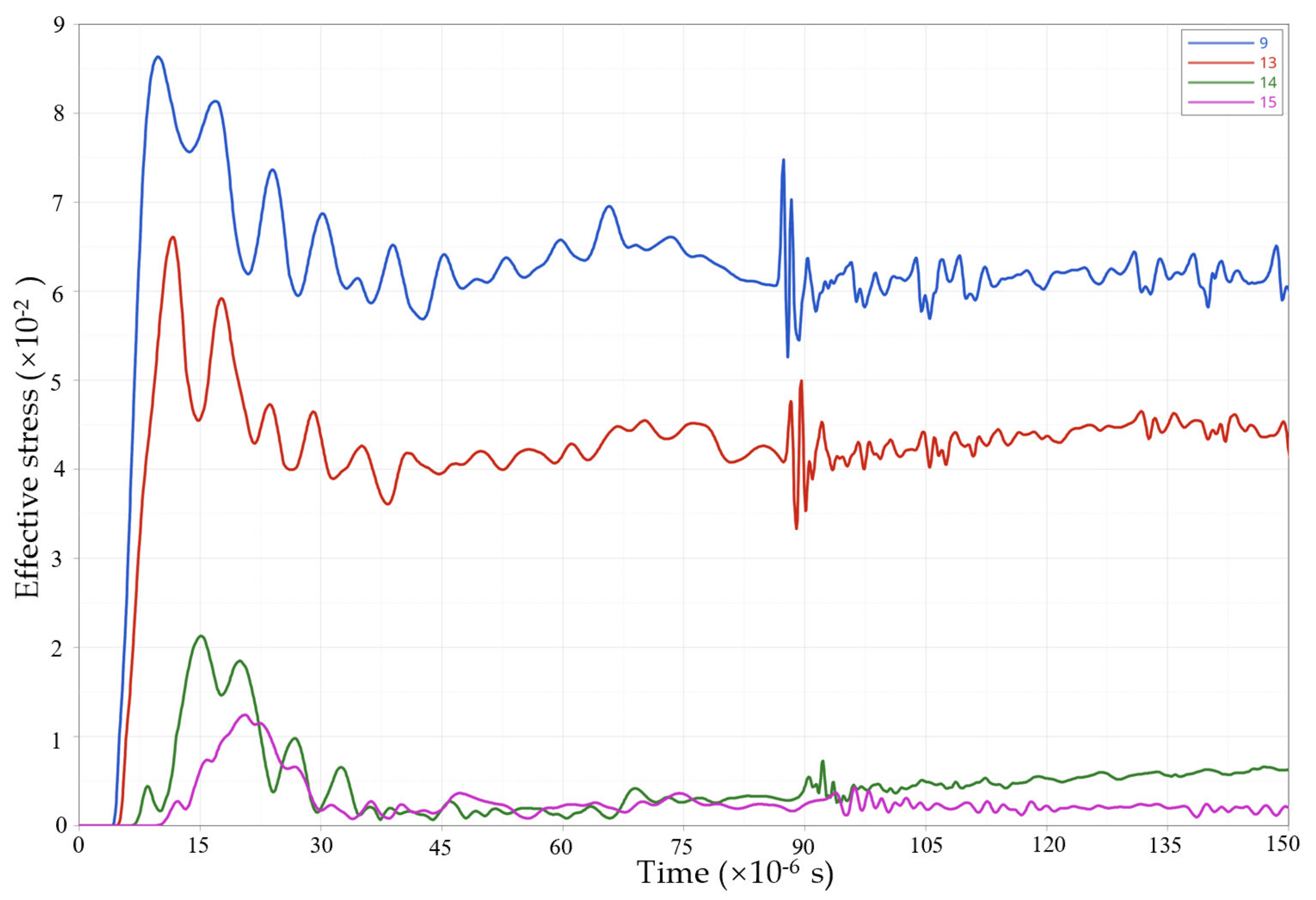
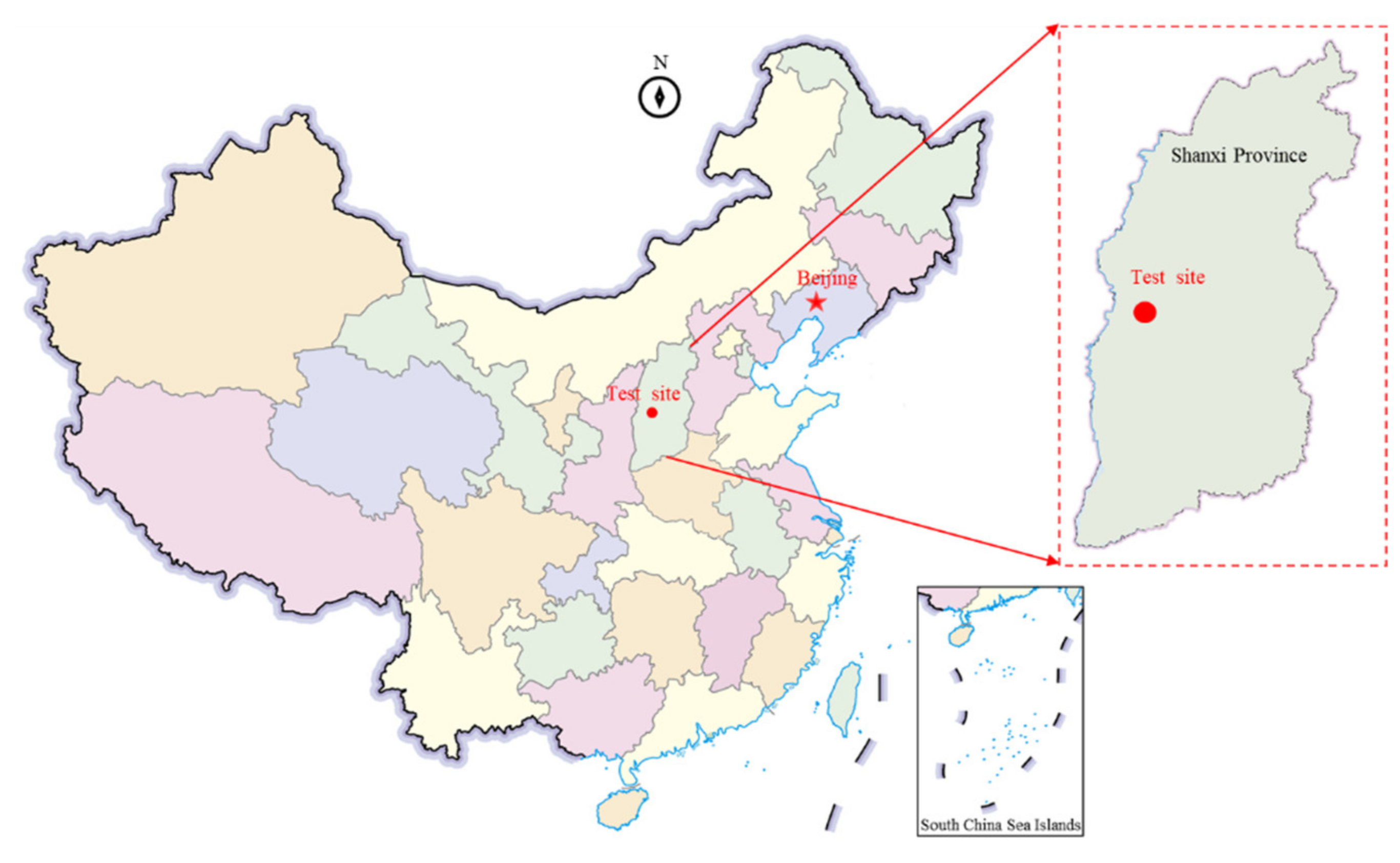
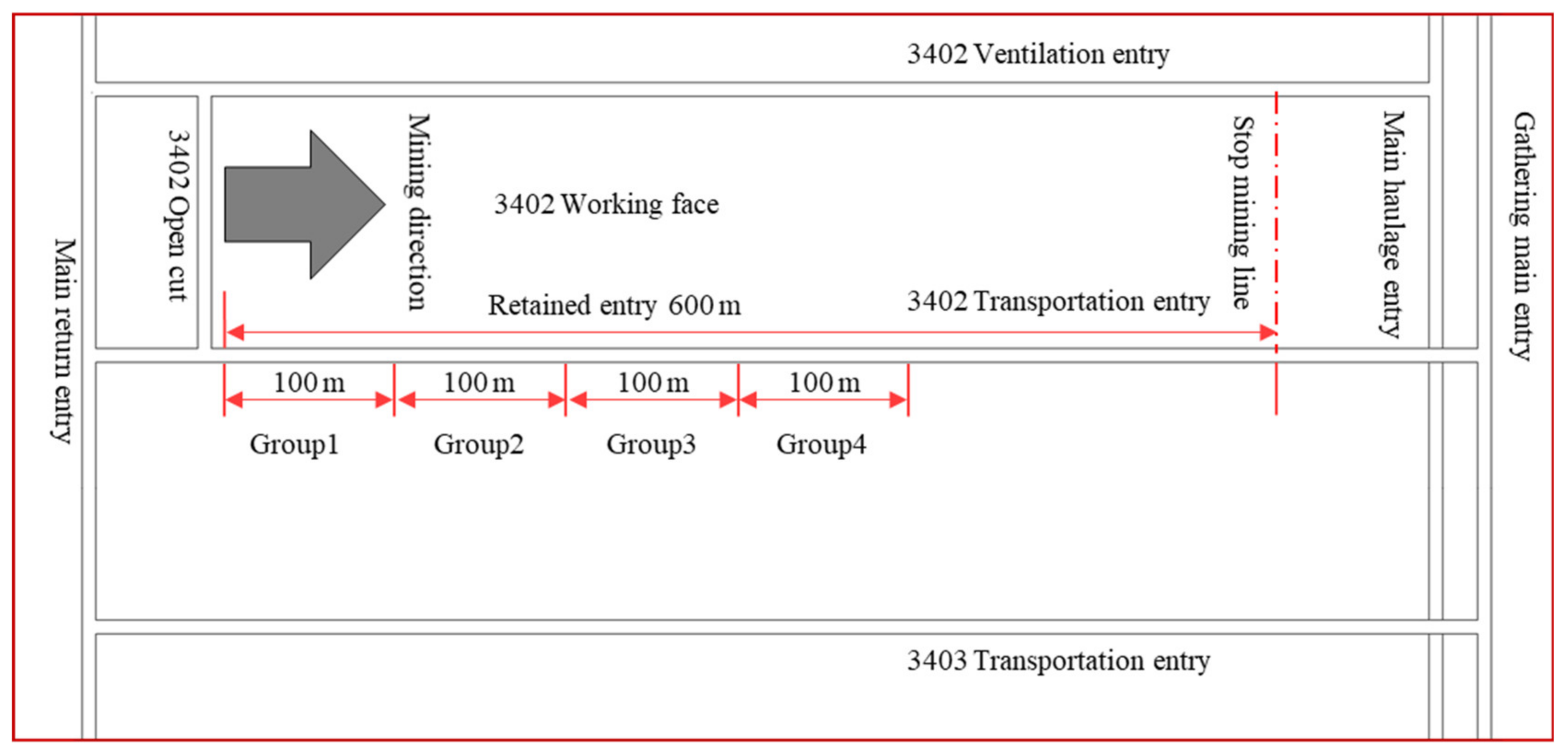
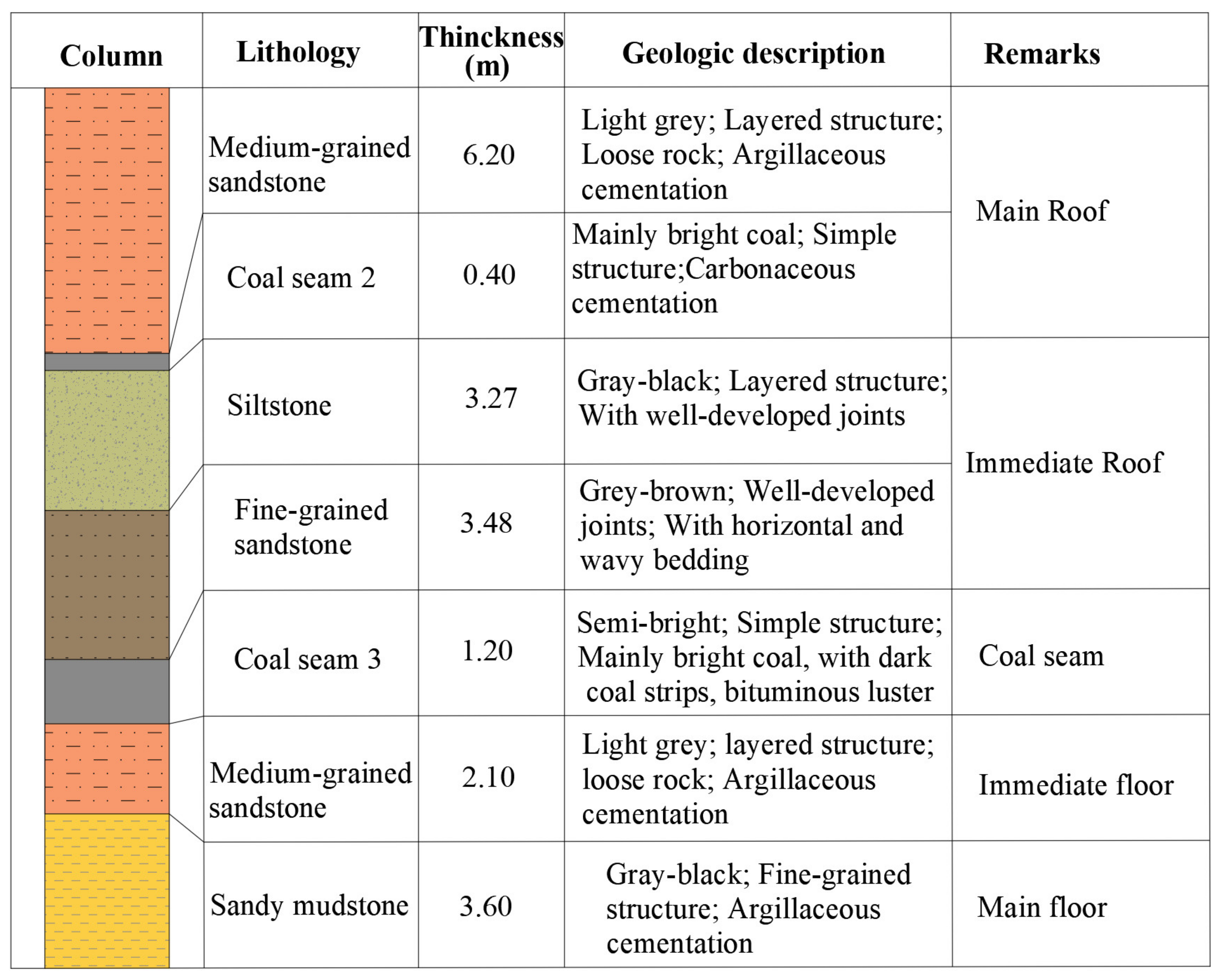
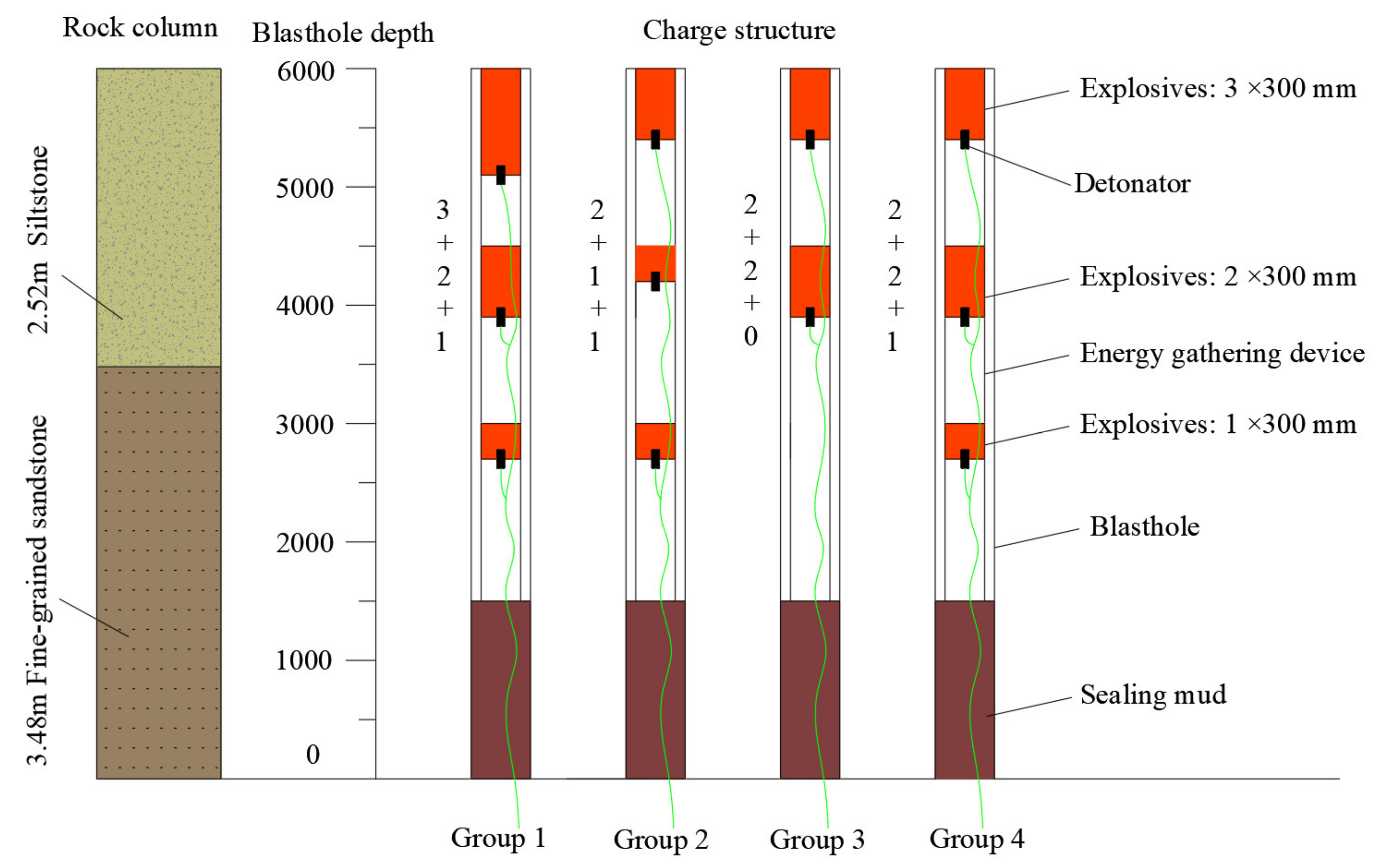
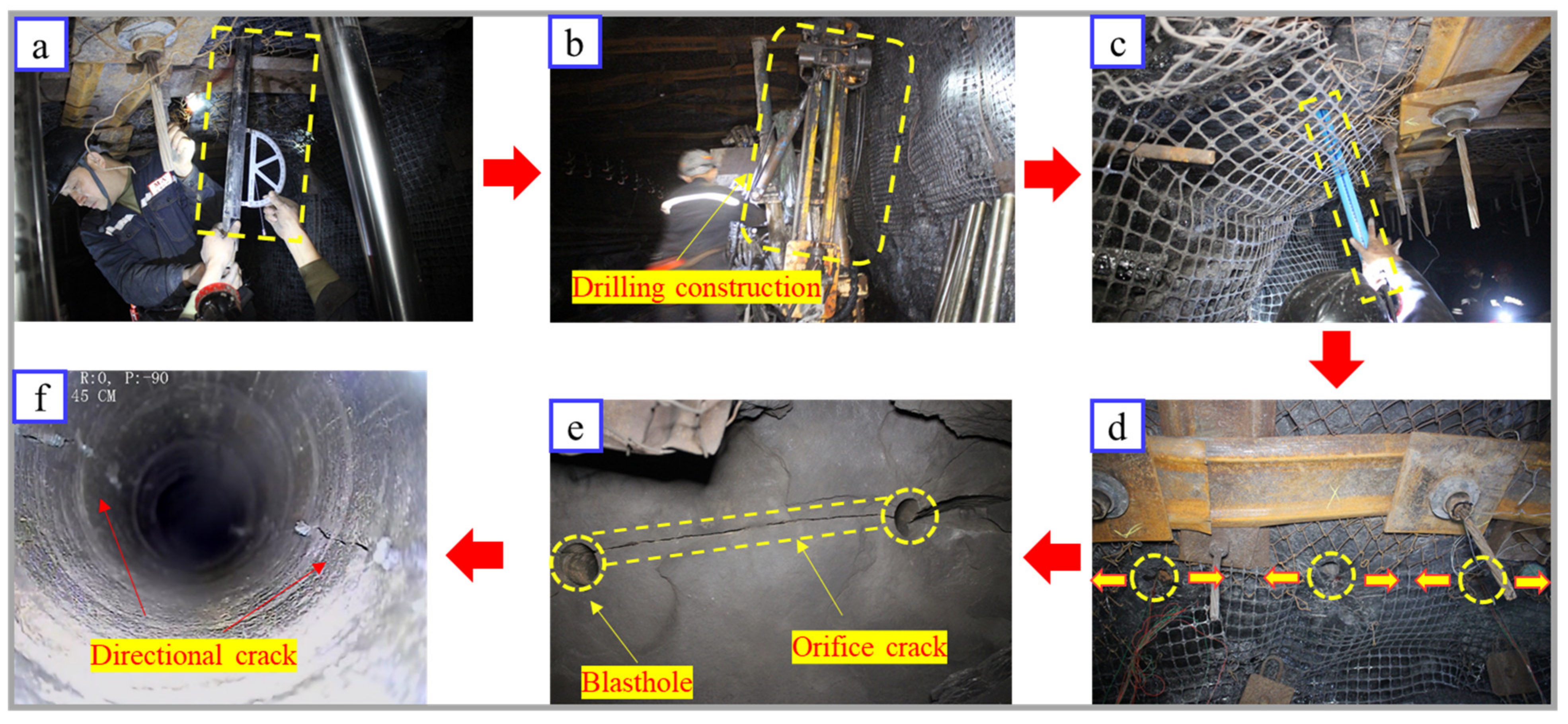
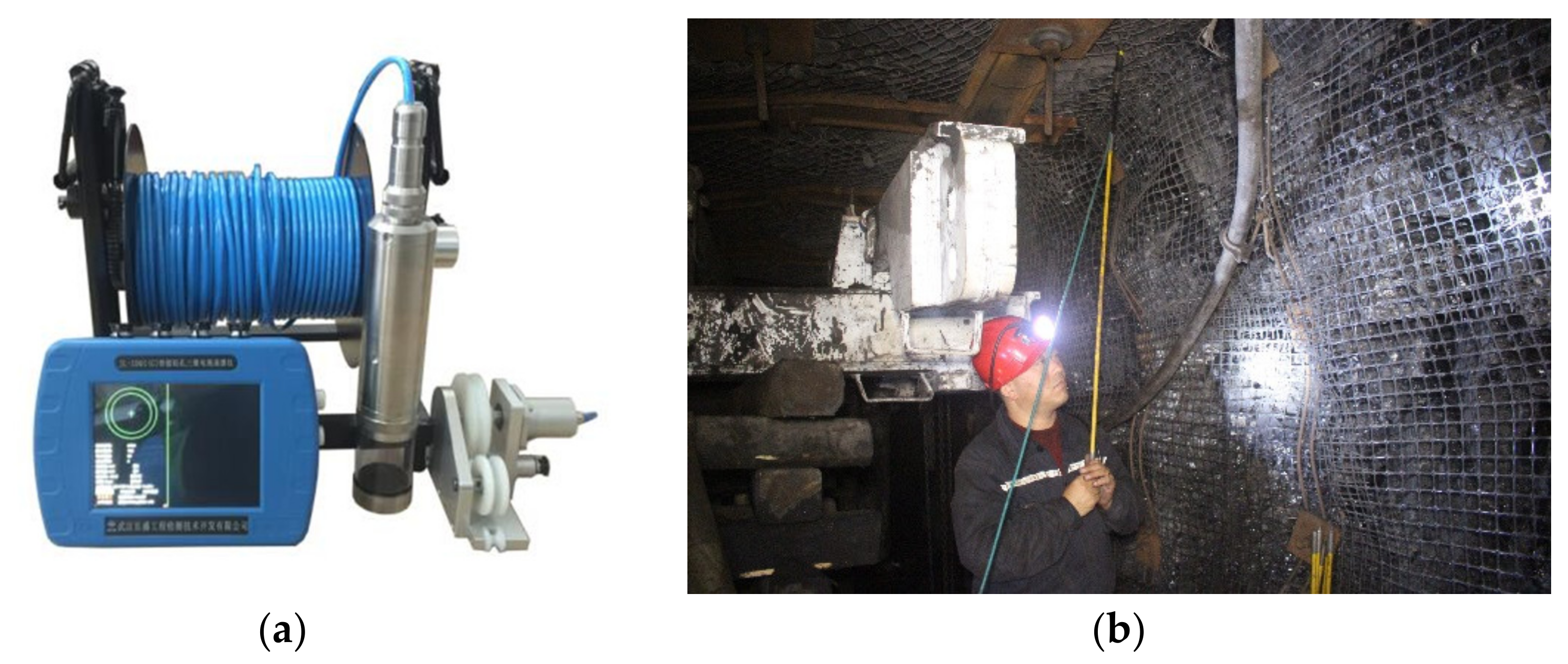
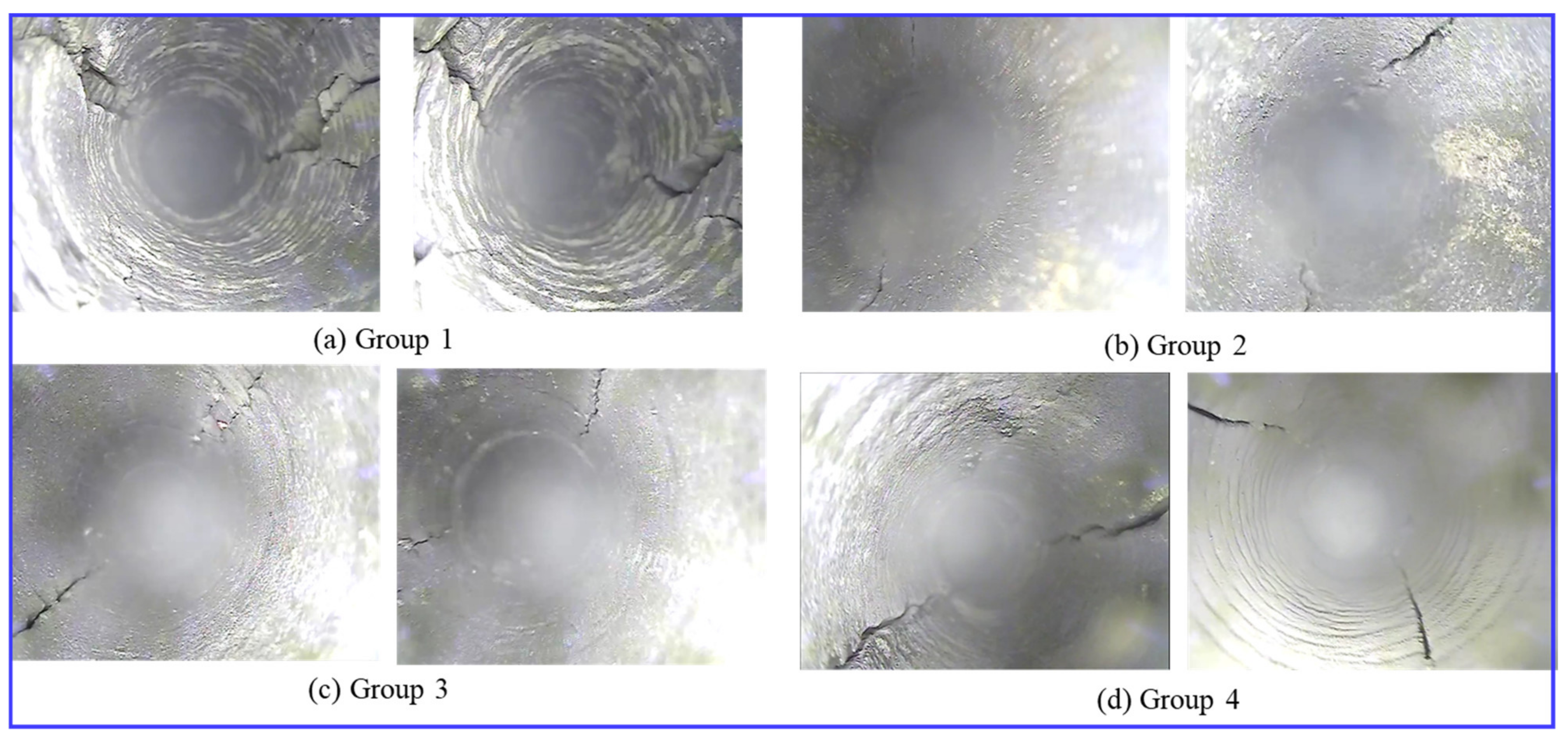
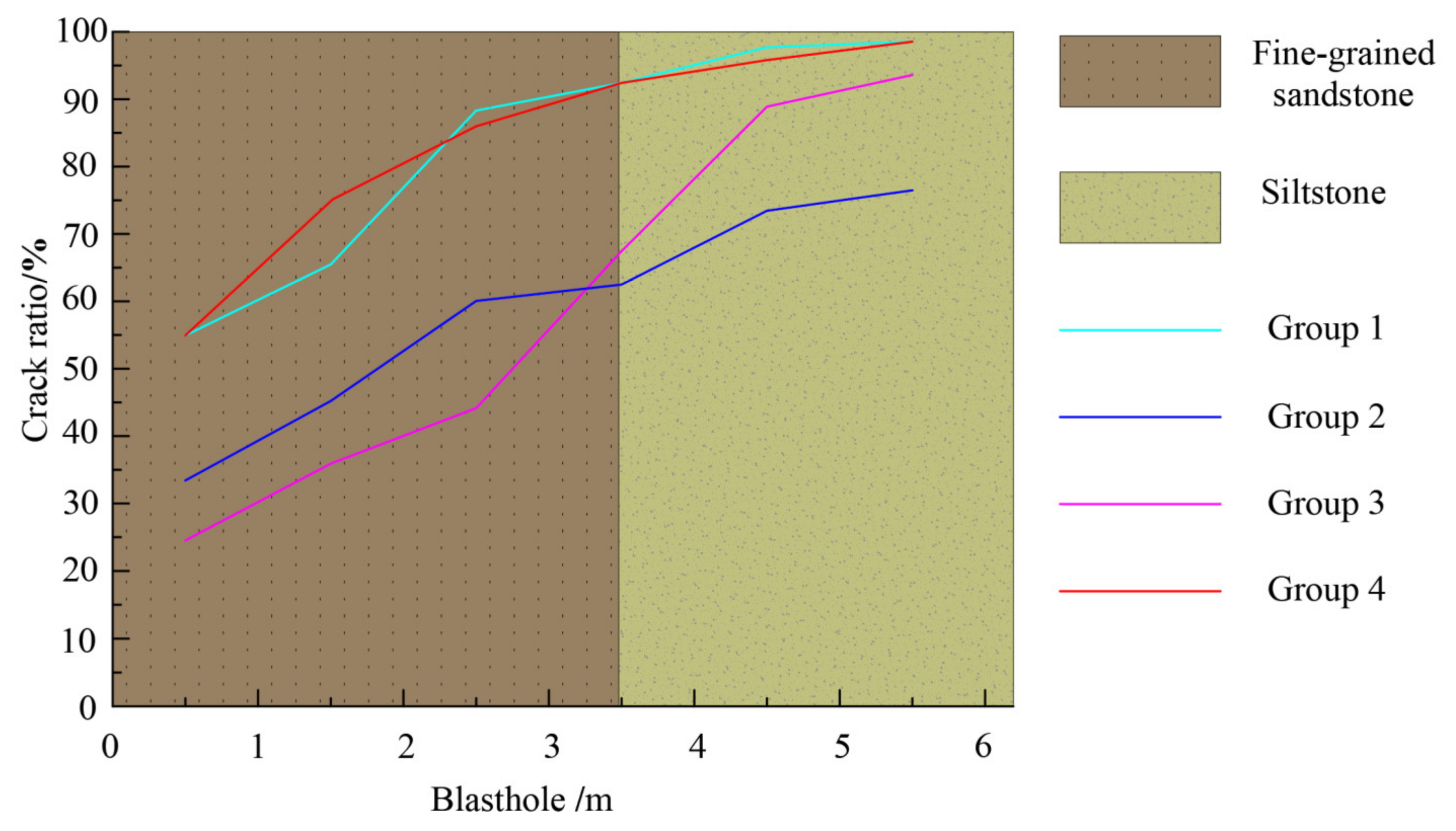
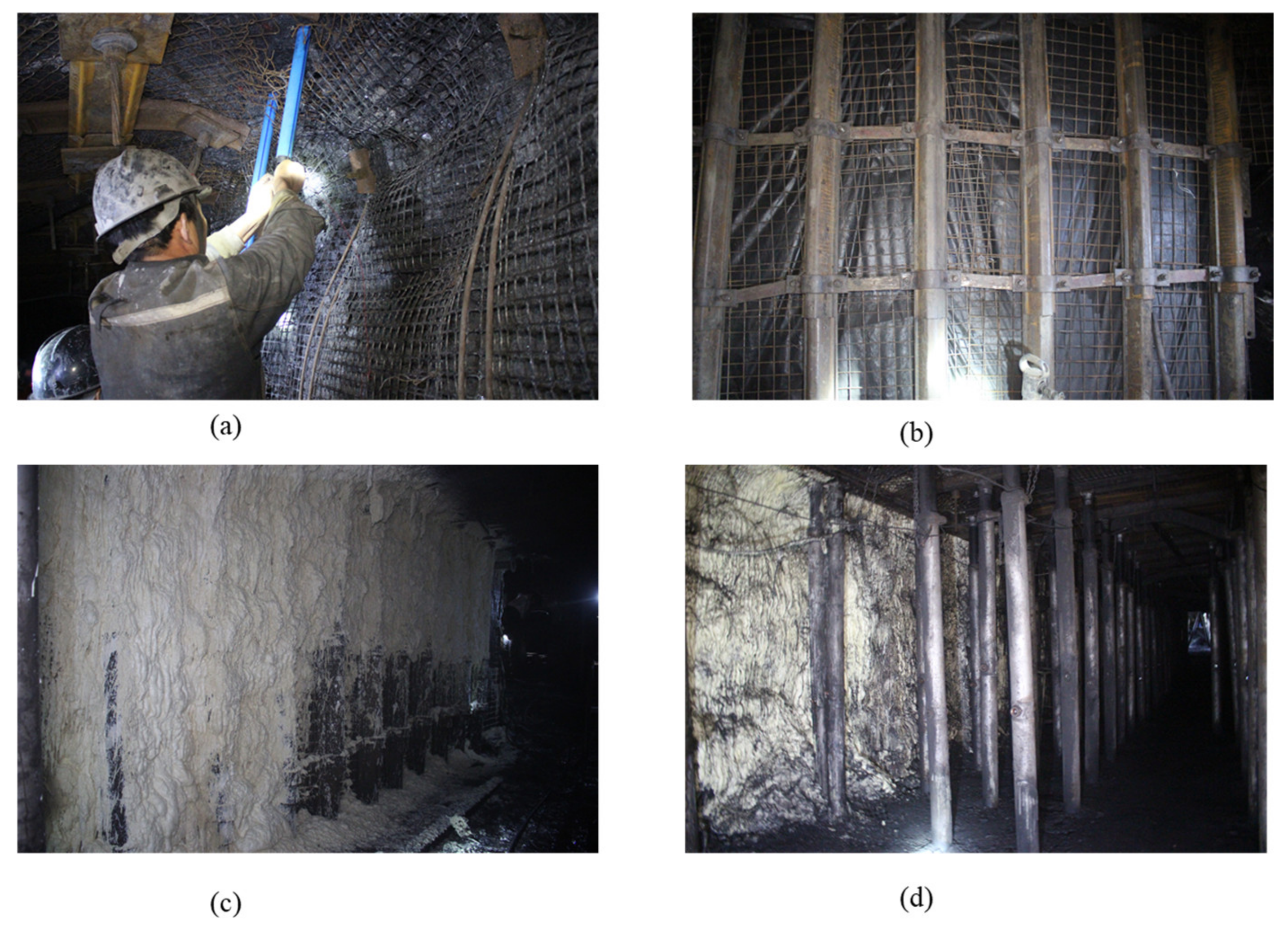
| Parameter | A/GPa | B/GPa | R1 | R2 | ω | V | E0/GPa |
|---|---|---|---|---|---|---|---|
| Value | 326 | 5.81 | 5.81 | 1.56 | 0.57 | 1 | 2.67 |
| Parameter | C/(cm/μs) | S1 | S2 | S3 | γ0 | a | E |
|---|---|---|---|---|---|---|---|
| Value | 0.387 | 1.82 | −0.075 | −0.043 | 1.58 | 0.41 | 2.67 × 10−6 |
| Parameter | C0 | C1 | C2 | C3 | C4 | C5 | C6 | E0 |
|---|---|---|---|---|---|---|---|---|
| Value | 0 | 0 | 0 | 0 | 0.4 | 0.4 | 0 | 2.5 × 10−6 |
Publisher’s Note: MDPI stays neutral with regard to jurisdictional claims in published maps and institutional affiliations. |
© 2021 by the authors. Licensee MDPI, Basel, Switzerland. This article is an open access article distributed under the terms and conditions of the Creative Commons Attribution (CC BY) license (https://creativecommons.org/licenses/by/4.0/).
Share and Cite
Gao, H.; Gao, Y.; Wang, J.; Fu, Q.; Qiao, B.; Wei, X.; Zhang, X. Study on Bidirectional Blasting Technology for Composite Sandstone Roof in Gob-Side Entry-Retaining Mining Method. Appl. Sci. 2021, 11, 7524. https://doi.org/10.3390/app11167524
Gao H, Gao Y, Wang J, Fu Q, Qiao B, Wei X, Zhang X. Study on Bidirectional Blasting Technology for Composite Sandstone Roof in Gob-Side Entry-Retaining Mining Method. Applied Sciences. 2021; 11(16):7524. https://doi.org/10.3390/app11167524
Chicago/Turabian StyleGao, Hainan, Yubing Gao, Jiong Wang, Qiang Fu, Bowen Qiao, Xingjian Wei, and Xingyu Zhang. 2021. "Study on Bidirectional Blasting Technology for Composite Sandstone Roof in Gob-Side Entry-Retaining Mining Method" Applied Sciences 11, no. 16: 7524. https://doi.org/10.3390/app11167524
APA StyleGao, H., Gao, Y., Wang, J., Fu, Q., Qiao, B., Wei, X., & Zhang, X. (2021). Study on Bidirectional Blasting Technology for Composite Sandstone Roof in Gob-Side Entry-Retaining Mining Method. Applied Sciences, 11(16), 7524. https://doi.org/10.3390/app11167524





